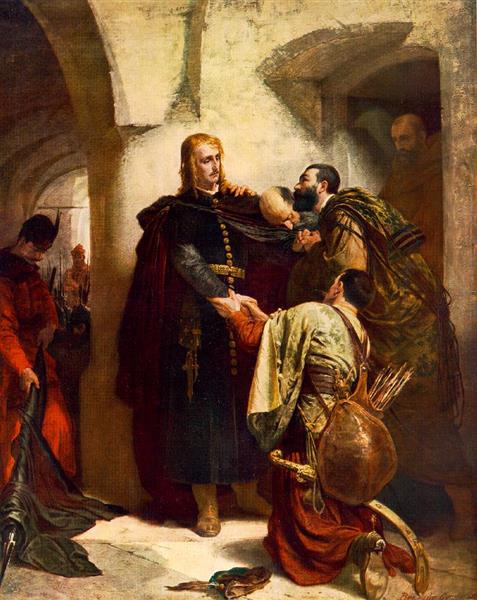Description
Gyula Benzúr, an outstanding Hungarian painter of the nineteenth century, achieves with "the farewell of Ladislaus Hunyadi" not only to capture a historical moment, but also to infuse it from an emotional depth and a meticulous attention to detail that invite the viewer to immerse themselves in the plot that It develops. The work, carried out in 1866, is inserted in the rich tradition of Hungarian romanticism, an artistic movement that sought to evoke nationalism and cultural identity through historical and epic references.
The painting tells a tragic episode in the history of Hungary: the execution of Ladislaus Hunyadi, son of the legendary Hungarian leader John Hunyadi. This fact resonates with great emotional burden, a circumstance that Benzúr plasma with a notable technical mastery. The scene develops in an atmosphere of deep drama, enhanced by the use of color and disposal of the characters.
The central focus of the composition is, without a doubt, Ladislaus Hunyadi. Dressed in a luxurious outfit, which contrasts with its gloomy circumstance, is surrounded by figures that express various emotions, from resignation to the most visceral pain. The detailed treatment of their garments and the thorough recreation of the architecture and the furniture that surrounds them provides a historical authenticity that places the viewer in the specific time and space.
To the right of Hunyadi, we can observe his mother, knee on the ground, holding his hand with despair. The inclined position and the gesture of clinging to his son accentuate the feeling of imminent loss. The lighting, which highlights its figures in contrast to the darkest background, directs our eyes towards the epicenter of action and emotion.
The use of color by Benzúr is particularly effective. Dark and earth tones predominate, which enhance the severity of the scene and the claustrophobic environment of the environment. However, the flashes of light and the subtle chromatic variations in the clothing and architectural details add a dimension of realism and vivacity, despite the gloomy issue of the work.
The composition of the painting is carefully thought. The characters are arranged in a semicircle around Hunyadi, creating a sensation of closure or completion, as if the inevitable fate was sealed. This order not only guides the viewer's view, but also symbolically encapsulates the proximity of the end of Hunyadi and the desolation he leaves for those around him.
As for the style, Benzúr aligns with the ideals of romanticism, but the influence of realism is also perceived, it manifests in the attention to detail and anatomical precision. This intertwining of styles reflects not only its pictorial skills, but also a deep understanding of history and the ability to infuse it with a shocking visual narrative.
Benzúr's work not only represents a key moment in Hungarian history, but also serves as a vehicle for reflection on loyalty, sacrifice and human tragedy. The artist's ability to communicate these complex emotions and his technical ability makes "the farewell of Ladislaus Hunyadi" a monumental piece, both in the context of Hungarian art and in the canon of European romanticism.
In conclusion, Gyula Benzúr's painting is not only a historical testimony, but also a deep artistic exploration of the human condition. Each line and each chromatic choice work in harmony to invoke an emotional response in the viewer, consolidating the work as an indisputable milestone in the history of Hungarian art.
KUADROS ©, a famous paint on your wall.
Hand-made oil painting reproductions, with the quality of professional artists and the distinctive seal of KUADROS ©.
Art reproduction service with satisfaction guarantee. If you are not completely satisfied with the replica of your painting, we refund your money 100%.

